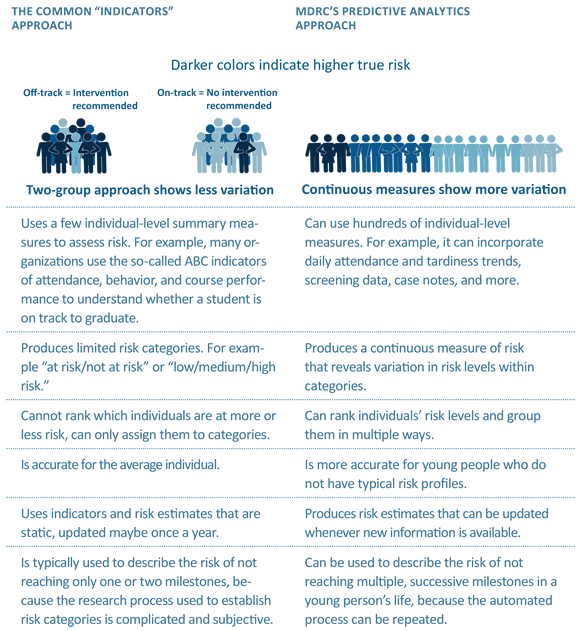What Can Schools, Colleges, and Youth Programs Do With Predictive Analytics?

THE PROBLEM: HOW TO ASSESS YOUNG PEOPLE’S RISK USING MORE DATA BUT LESS TIME
A SOLUTION: PREDICTIVE ANALYTICS
- Rank young people by their risk levels
- Show variation in young people’s risks and needs at a single point in time
- Capture changes in risk as new information is collected

THE RESULT: REAL-TIME ESTIMATES OF INDIVIDUALS’ RISKS THAT CAPTURE VARIATION
- Absence: What is the likelihood that an individual will miss school or program participation more than 10 percent of the year?
- Course failure: Which students are most likely to fail a required exam in a given subject?
- Completion: Is a young person more at risk of not completing Program A or Program B?
- Variation in risk: How is the risk of not graduating on time spread among schools or centers in a district?
- Change in risk: How do young people’s risks of not completing a program change during the course of a year?
WHAT IT TAKES
- MDRC works with an organization to assess whether predictive analytics are appropriate and valuable for its goals and questions.
Are predictive analytics right for your organization? Yes, if you:
- Already assess or guess at young people’s risk of not reaching certain milestones, and want to improve the accuracy of your risk assessments.
- Can implement interventions meant to help young people at risk.
- Make the most of limited resources by directing services only to those at risk.
- Believe that targeting services based on risk will increase the success of an intervention.
- If so, we investigate how ready the organization is for predictive analytics.
Is your organization ready for predictive analytics? Yes, if you:
- Make data readily available that are updated throughout the year.
- Are ready to communicate and act on results.
- Employ a staff and a data system that can sustain predictive work.
- MDRC works with the organization to identify which milestones we should focus on. We choose ones where there are enough good data to work with and where the risk involved is relevant to the organization’s decisions about interventions.
- For each milestone we choose with the organization, we calculate a likelihood that each individual will not reach that milestone.
- We help the organization incorporate these results into its tracking systems. We help it prepare to sustain predictive analytics and incorporate the approach into its continuous improvement processes.
We also help organizations understand the limitations of predictive analytics. Predictive analytics can only assess risk — they do not reveal anything about the effectiveness of an intervention. But MDRC can use other rigorous methods, such as randomized field trials, to answer those questions. Our experience from evaluating dozens of youth programs as well as designing interventions informed by behavioral science can help organizations decide what to do next: how best to intervene and with whom.







